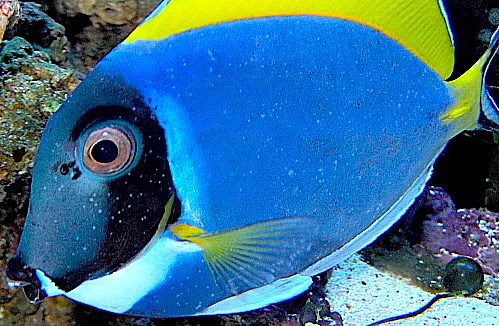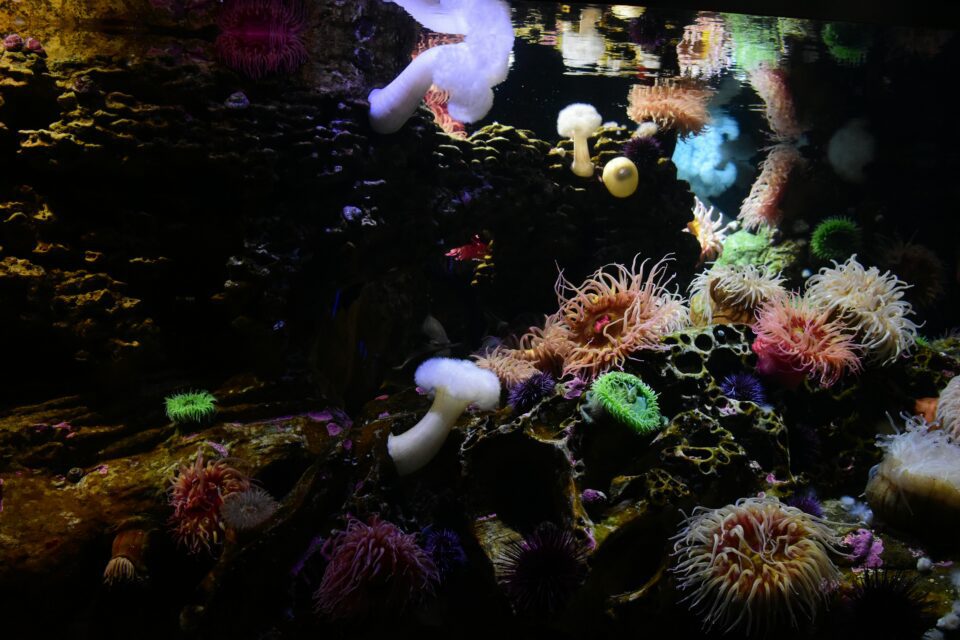Ich is a disease that looks like white dots on the fish. They are not actually ich but more scabs that show where the ich has penetrated the fish. The rule of thumb is that if you can count the dots, it’s ich… if its too many to count (looks like millions) and becomes fuzzy, its velvet. Look at the picture below and verify you have ich

Ok, so you have ich.. now what.
First there are two considerations, do you have inverts in the tank or is it fish only. For fish only (fowlr) skip to section two, for tanks with inverts and/or coral, section one.
Ich Treatment in a Reef Tank with Inverts
This is hard, the only solution to remove ich completely is to quarantine the fish. That involves setting up a dedicated system using copper and waiting the prescribed amount of time, follow this link for quarantine instructions. How to Quarantine
If you cannot quarantine, then the following is your best solution.
Ingredients:
- 1 Bottle of 3% hydrogen Peroxide
- 1 Vitamin Supplement (Selcon, VitaChem or Kent Zoe)
- 1 Garlic Supplement (Garlic Guard, Kyolic Garlic etc)
- 1 Beta Glucan Suppliment
- 1 High quality frozen food (LRS etc)
- 2 Cleaner Shrimp
- 1 Properly sized UV Plumbed in line, tuned to correct flow Setting up a UV
Recipie:
- Increase Temperature to 80.6F 1 . Make sure you accurately measure the temp so you don’t go high enough to harm any livestock. This increases the speed of the ich lifecycle.
- Decrease lighting intensity and hours 2 (corals only need 6 hours and can survive with lower intensity for long periods of time), this decreases stress in fish.
- Use Cardboard to block off portions of the tank to allow the fish to feel more secure and less observed. Stress causes ich to flare up and weakens immune systems, so ideally you would reduce it as much as possible.
- Feed high quality frozen food to maintain health and immune systems. Take an appropriate size of frozen food and soak it in vitamin suppliment, garlic and Beta Glucan 3. Supplements and Beta Glucan have been shown to improve immune systems in studies on ich. For Beta Glucan, use 1/2 tablet for every 8 cubes of fish food you use, adjust accordingly to your tank.
- Add Cleaner Shrimp to the tank. Up to 2 can be held in a tank together, abd they have been proven to eat ich on marine fish in a large scale study.4
- Follow these instructions for Hydrogen Peroxide Dosing5 Peroxide Dosing Instructions – This is still experimental but shows very, very promising results. We have used this many times with no ill effects.
- Install UV if possible. If you do install a UV, dose the Hydrogen Peroxide into the inlet of the UV, it has been shown to increase the effectiveness of UV dosing.
Emergency:
If your fish is having trouble breathing do a fresh water dip. Fresh water dip kills the ich fleas on the gills of the fish, allowing them to breath.
Dip the fish in rodi water, or tap water that has been dechlorinated with Prime, that is the same temperature and PH as the tank water to minimize shock. Keep the fish in as long as it can handle it, up to 15-20 minutes. If the fish starts to panic of shows signs of struggling to breath, put them back in the saltwater.
Ich Treatment in FOWLR system (fish only)
It is possible to treat ich in a FOWLR system. We still recommend quarantining your fish, but if that is not possible, you have two options.
Option 1 – Using Copper
Ingredients
- Copper Power – this is a chelated copper and has been shown to be safer for fish, and easier to remove from your system. This is the only brand we recommend.
- Hanna Copper Checker
- Cupisorb
- Metasorb
Recipie
If applicable, run carbon for 24 hours to remove any residuals from non-copper medications you have previously dosed. Then remove carbon and raise the tank to 2.0 ppm using Copper Power. Take a few days to further raise the Cu level to 2.5 ppm. Treat at this concentration for 30 days OR 14 days and then transfer to a new/sterile tank for observation, we recommend the full 30 days if fish are doing well.
At the end of this period use Cupisorb and/or Two Little Fishies Metasorb to remove the copper from the tank.
Option 2 – Chloroquine phosphate
Ingredients
- Chloroquine Phosphate6
- Digital Scale that does mg and small quantities
Recipie
Chloroquine is dispensed in powder form, and a digital scale is needed to accurately weigh the dosage.
- 10 mg/L (40 mg/gal) is the standard dosage.
Chloroquine phosphate, unlike copper, is subject to biodegradation, meaning it gets eaten by the bacteria in your tank. So it needs to be redosed regularly.
Start off by dosing 10 mg/L (40 mg/gal), and then subsequently dose 1 mg/L (4 mg/gal) every day thereafter for 10-14 days. Chloroquine has a wide therapeutic range (40-80 mg/gal), so the objective is to keep it within that concentration at all times. Keep water temp between 78-80F while treating.
The reason to treat for only 10-14 days is there have been some anecdotal reports of toxicity issues when exposing fish to long-term Chloroquine. Generally speaking, treat for the full 14 days if the fish is eating/acting fine. However, you can pull the fish out as soon as 10 days if you are noticing increased appetite suppression, lethargy or other side effects.
Pros: Well tolerated by most species of fish. (Especially sharks, rays & eels – none of which will tolerate copper.) Chloroquine treats most external protozoa, and is probably the closest thing there is to a “wonder drug” in our hobby.
Cons/Side Effects: Expensive, can be hard to get, powder is heat & light sensitive – so store in a cool, dark place. Chloroquine is rapidly removed from the water if carbon is used or even by certain filter pads. The medication is also susceptible to biodegradation, which makes dosing in an established QT (or DT) unpredictable. There have been some reported toxicity issues, especially when a fish is immediately moved from copper to chloroquine (or vice versa). Avoid using chloroquine with the following fish:
Known Chloroquine Sensitive Fish
- Anthias (Lyretails seem least sensitive)
- Hippo Tangs
- Seahorses & Pipefish
- Wrasses of the Coris, Paracheilinus, Pseudocheilinus genera
* With regards to Chloroquine sensitivity by fish species, see also: Chloroquine Phosphate Treatment – Which Fish
______________________________________________________________________________________
References
- https://www.sciencedirect.com/science/article/abs/pii/S0044848617317544 https://www.jstor.org/stable/3284114?seq=1
- https://www.ncbi.nlm.nih.gov/pmc/articles/PMC9075632/
- https://www.sciencedirect.com/science/article/abs/pii/S1050464821000450#:~:text=Regardless%20of%20the%20administration%20period%2C%20%CE%B2%2Dglucan%20enhanced%20the%20immune,protection%20against%20the%20bacterial%20challenge.
- https://www.nature.com/articles/s41598-018-32293-6
- Montgomery-Brock, D., V. T. Sato, J. A. Brock, and C. S. Tamaru. 2001. The application of hydrogen peroxide as a treatment for the ectoparasite Amyloodinium ocellatum on the Pacific threadfin Polydactylus sexfilis. Journal of the World Aquaculture Society 32:250–254.
- https://reefs.com/magazine/aquarium-fish-chloroquine-a-new-drug-for-treating-fish-diseases/




